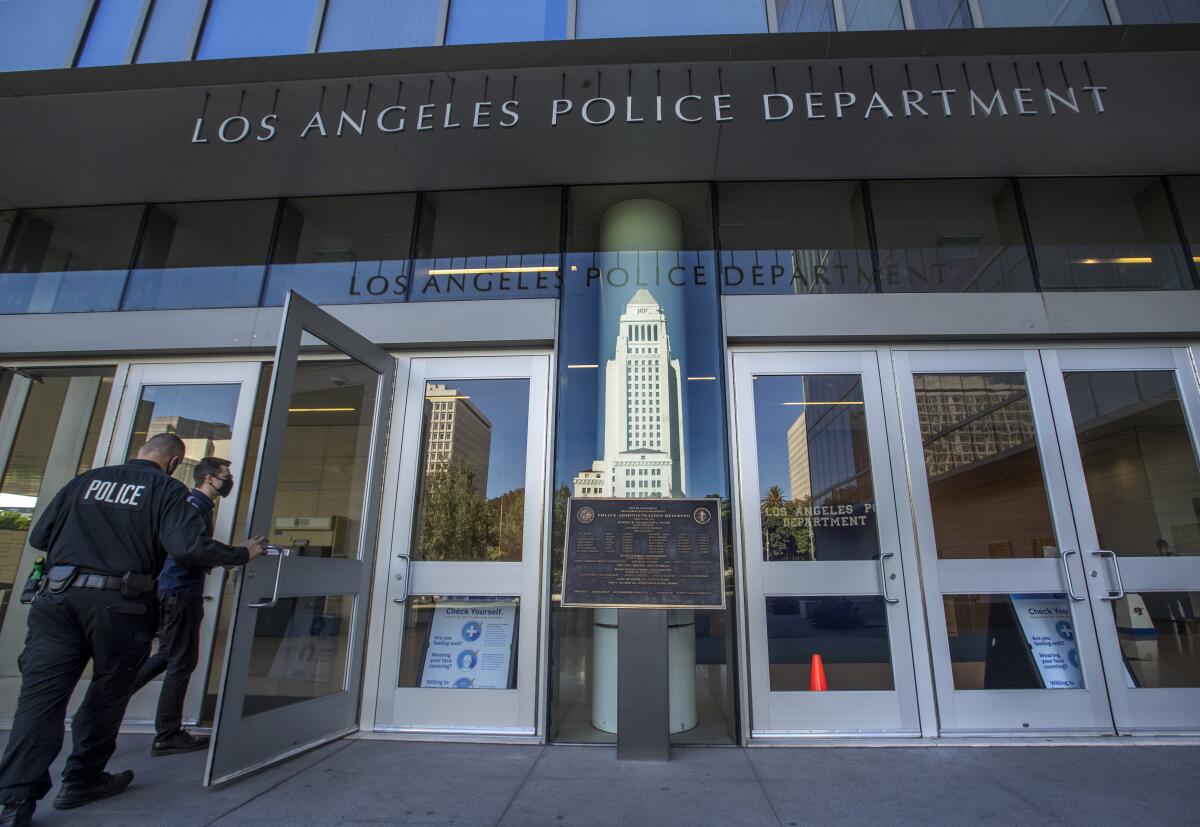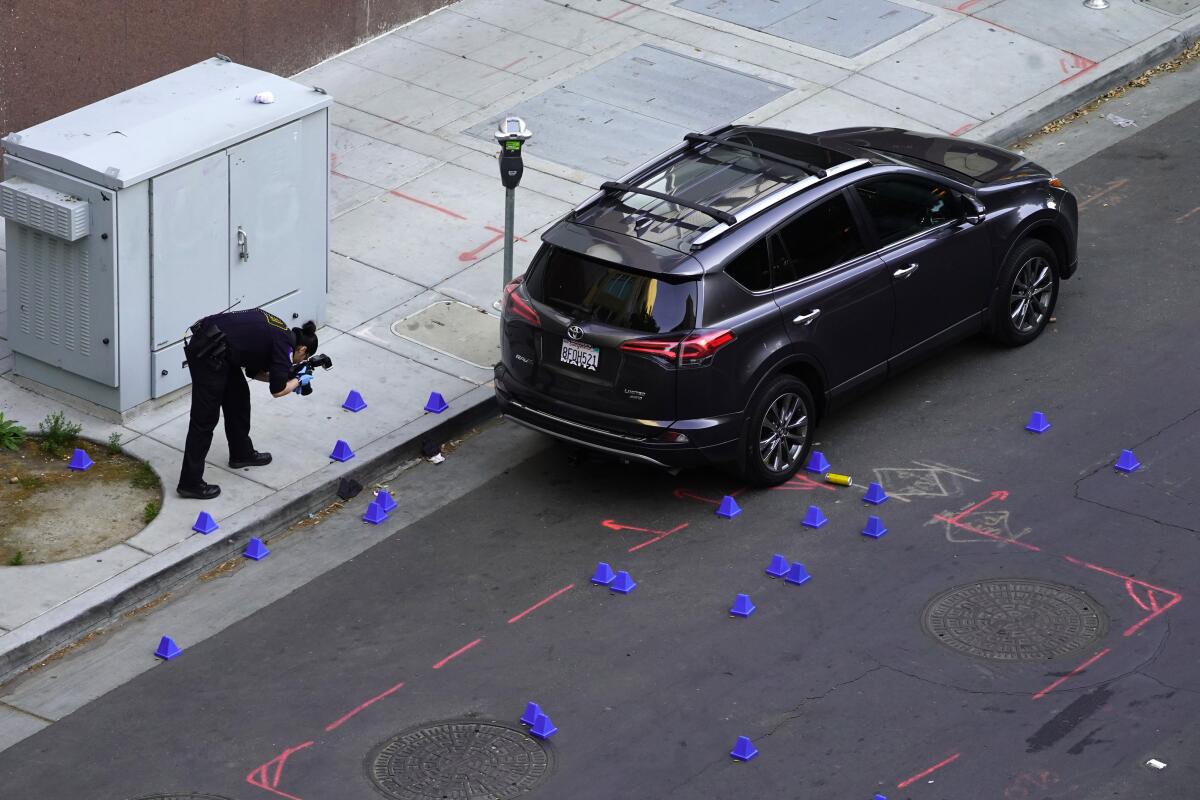A notorious LAPD settlement, revisited: An investigation into a gang murder goes off the rails

- Share via
Good morning, and welcome to the Essential California newsletter. It’s Wednesday, April 6. I’m Justin Ray.
This is part one of a two-part series about Juan Catalan’s wrongful imprisonment. Here’s part two.
Journalists at The Times have had some tense run-ins with law enforcement. Two weeks ago, columnist Gustavo Arellano detailed his relationship with L.A. County Sheriff Alex Villanueva. NPR also released a story about the LAPD’s fraught relationship with reporters who work for The Times and elsewhere, highlighting the journalists who were detained or arrested during the 2021 Echo Park homeless encampment protest.
It makes sense that journalists wouldn’t be friends with law enforcement for one reason: We reveal their flaws. But this accountability is important, because legal authorities have the power to drastically impact lives. That is abundantly clear when considering one bizarre, notorious case that resulted in a settlement involving hundreds of thousands of dollars, issued 15 years ago.
In a two-part series today and Thursday, I will revisit Juan Catalan’s case because it says so much about our criminal justice system and how sometimes outcomes are dictated more by happenstance than we probably would like. This account was compiled through years of Times reporting, as well as from other sources that have been cited in the story.
The story begins with the death of a 16-year-old girl. On May 12, 2003, Martha Puebla was sitting on the curb outside her Sun Valley home while chatting with a friend. A man walked up from behind the pair.
“Who are you?” he asked Puebla.
“I’m Martha,” she said. “You know me.”
The man then removed a 9-millimeter handgun from his sweatshirt pocket and began firing. The fatal shot was so close to her face that it left burn marks on Puebla’s cheek.
Soon afterward, Martin Pinner was contacted while he was at home. The LAPD homicide detective had previously visited that location, where he had talked to the teen about the shooting five months earlier of Christian Vargas.
Vargas had been dating a friend of Puebla (whom The Times never has identified, for her protection). On Nov. 27, 2002, Vargas had been sitting in a car, while the two girls chatted through a window of Puebla’s house. When shots rang out, the other girl jumped through the window and began cowering in Puebla’s room.
According to police, an early suspect in the crime was Jose Ledesma, a member of the Vineland Boyz, a notorious gang responsible for drug sales in Sun Valley. The unnamed friend who’d been dating Vargas told detectives that Puebla had identified Ledesma as the shooter who’d killed Vargas.
When police later questioned Puebla, she told detectives that she was merely speculating about Ledesma’s possible involvement. In fact, “Puebla did not did not tell law enforcement many details about the crime,” The Times reported.
Nevertheless, authorities searched the home of Ledesma’s family. Under his mattress, they found a loaded assault rifle and letters from other Vineland Boyz. Ledesma wasn’t home at the time; detectives were told he was hanging out with another gang member, Mario Catalan.
In actuality, Ledesma and Catalan had fled to Tijuana. But only two days after the home search, Mexican police responded to a domestic abuse call from someone who heard Catalan and his girlfriend having an intoxicated fight. When Mexican authorities questioned her, the girlfriend informed them that the men were wanted for murder in L.A., The Times reported. Ledesma and Catalan were soon extradited to LAPD’s North Hollywood station.
Later, during an interrogation, Pinner, the LAPD homicide detective, told Ledesma that he had witnesses who would testify that Ledesma was responsible for Vargas’ homicide. To back up this claim, Pinner displayed what is known as a “six-pack,” an array of mug shots that detectives often show to witnesses or victims of crimes in order to identify suspects.
Ledesma’s photo was circled, and the initials “M.P.,” presumably for “Martha Puebla,” were written below it. “Those is the guy that shot my friends boyfriend” was scrawled along the margin, followed by Puebla’s signature.
When other detectives searched the car that Ledesma and Catalan had driven to Mexico, they found a handgun that would eventually be matched to Vargas’ death and another killing that had taken place the same week.
After informing Catalan about the weapon’s discovery, Pinner then placed him and Ledesma in a holding cell with a hidden microphone in hopes that the two suspects would confess something damning. At this point, Catalan told Ledesma that authorities had found the gun in the vehicle.
The night after he heard about the gun, Ledesma used a pay phone outside his cell. He called a friend. The conversation was in a mix of Spanish and English. The recording of the call, Pinner said in sworn testimony, was badly transcribed twice by an outside company used by the LAPD. (Remember this detail, because I will return to it tomorrow. Despite how innocuous it seems, it is perhaps the most infuriating part of this entire case.)
In tomorrow’s newsletter, I’ll explain how a man found himself jailed over Puebla’s death, and how HBO played a role in proving that he wasn’t the one who took the teen’s life. I’ll also explain how the answer to the case was available to detectives the whole time.
And now, here’s what’s happening across California:
Note: Some of the sites we link to may limit the number of stories you can access without subscribing.
The latest on the shooting in Sacramento

Sacramento police have announced the arrest of Smiley Martin — brother of Dandrae Martin, who was also previously charged over the massacre. Authorities also said that stolen firearm used in the shooting in Sacramento on Sunday was converted to be used as a fully automatic weapon, police said.
Other stories:
Editorial: Gun violence is America’s way of life — and death. “On the same day that this horrific shooting rocked Sacramento, at least 95 other shootings took place across the nation. Yes, you read that correctly.”
‘A beautiful soul’: Homeless woman is killed in Sacramento mass shooting. Melinda Davis, 57, “had a really good personality,” and “never started trouble,” her friend told The Times.
Our daily news podcast
If you’re a fan of this newsletter, you’ll love our daily podcast “The Times,” hosted every weekday by columnist Gustavo Arellano, along with reporters from across our newsroom. Go beyond the headlines. Download and listen on our App, subscribe on Apple Podcasts and follow on Spotify.
POLITICS AND GOVERNMENT
The city of Oakland and the Oakland Athletics are facing another lawsuit over the $12-billion waterfront ballpark and surrounding development at Howard Terminal. The lawsuit, filed in Alameda County Superior Court, alleges that the city did not “sufficiently analyze and mitigate public safety risks and other impacts associated with the large number of motor vehicles, bicycles, and pedestrians that will have to cross the heavily trafficked” railroad tracks.” Dave Kaval, president of the A’s, criticized the lawsuit and said the current railroad situation is “completely untenable.” The project is one of the largest in the state and is expected to bring housing, jobs, tax revenue and economic development to Oakland. San Francisco Chronicle
As L.A. County unveils the most ambitious ‘free money’ program to date, research indicates that such programs help participants regain control of their lives. If you live in a poor or working-class neighborhood in Los Angeles County, you may be eligible to receive $1,000 a month for three years with no strings attached. “Study after study shows that participants in these programs do well, so much so that their health improves,” writes columnist Minerva Canto. Capital and Main
CRIME, COURTS AND POLICING
Paranoia and mash-up of conspiracy theories gripped surf instructor before child killings. Here’s what we know about Matthew Taylor Coleman’s disturbing activities, weeks before he allegedly killed his two young children with a spearfishing gun in Mexico. Los Angeles Times

Support our journalism
HEALTH AND THE ENVIRONMENT
Community college students face housing insecurity. At least eight students at Long Beach City College have been given permission to sleep in their cars in a campus parking facility, as part of an official campus program to help students who cannot afford a place to live. The community college’s parking garage, which has a security guard, Wi-Fi, and bathrooms nearby, is seen as a safer alternative to students sleeping in their cars on the street. These students are not alone: “The latest statewide survey, published in 2019, found that 19% of California community college students had experienced homelessness in the past year, and 60% had experienced some kind of housing insecurity,” writes Louis Beckett. The Guardian
The avian soap opera unfolding atop this Berkeley bell tower has humans riveted. A saga involving a peregrine falcon has created an emotional rollercoaster for the university’s community. Los Angeles Times

CALIFORNIA CULTURE
Column: She helped win an early fight for gay rights. Now it feels like history is repeating itself. In 1978, Gwenn Craig helped lead the fight against Proposition 6, a California ballot measure that would have banned gays and lesbians from working in public schools. Now, with lawmakers across the country passing laws to restrict what teachers can say about sexual orientation and how parents can engage with their transgender children, it seems as though the work of protecting LGBTQ rights isn’t done. Los Angeles Times
How Southern California created fast food. In the mid-20th century, Southern California experienced a boom that created a thriving economy, spreading suburbia and car culture. This “created Fast Food America, a universe of its own, with a constellation of burger-and-burrito chains, all composed of the basic elements of salt, fat, sugar and pleasure,” writes columnist Patt Morrison. Los Angeles Times
Thirty-nine fantastic independent nurseries that SoCal plant lovers will adore. For plant lovers, browsing a new nursery is as thrilling as going on a first date with a crush. If only there were a Tinder for garden centers. While you can’t swipe right on potential nursery matches, you can scroll through our compendium of excellent independently-owned nurseries in Southern California. Los Angeles Times
Free online games
Get our free daily crossword puzzle, sudoku, word search and arcade games in our new game center at latimes.com/games.
CALIFORNIA ALMANAC
Los Angeles: Sunny 90 San Diego: Sunny 74 San Francisco: Sunny 74 San Jose: Sunny 86 Fresno: Sunny 86 Sacramento: Sunny 88
AND FINALLY
Today’s California memory is from Marge Holley:
While working on our family tree, I found my aunt’s application for a job in 1943. One previous employer was Pacific Enamel, 17th and Los Angeles Street. The position held was inspector on radio boxes. The salary was $.65 an hour. Before that, auntie worked at Owl Drug store, 8th and Broadway, as sandwich girl and assistant manager. The salary was $25 a week. It was a trip down memory lane.
If you have a memory or story about the Golden State, share it with us. (Please keep your story to 100 words.)
Please let us know what we can do to make this newsletter more useful to you. Send comments to essentialcalifornia@latimes.com.
Sign up for Essential California
The most important California stories and recommendations in your inbox every morning.
You may occasionally receive promotional content from the Los Angeles Times.







